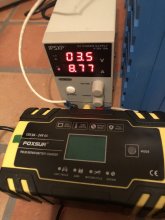My advice would be to hook them up in serial again with the BMS. Then set your power supply to 29 volts and use it instead of the battery charger which doesn't appear to have a lithium setting. At 10 amps, looks like your power supply is more powerful than the charger anyway.
Likely the charger thinks (without a Lithium setting) that your battery is already charged.
This looks like your charger, and I hate to say it, but it will not work for Lithium cells, only lead acid and AGM.
Having said that, 8 times 3.65v is 29.2 volts, and 10 amps at nearly 30 volts would be running the power supply all out. In other words, you might wish to limit the current to 8 amps rather than 10, simply because these Chinese power supplies like to die when run at 100% for extended periods of time. Your power supply will work better and faster than the charger. Overkill makes a quality BMS, just make sure the cell high limit is set to 3.65 volts, and it should stop the charge the moment the first cell is full. Then you can parallel the cells for the last top balance (in the meantime, charging as a pack means 1/8th the time, because each cell is getting 8 to 10 amps, rather than 8 to 10 amps divided by 8).



